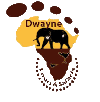Republic of Botswana
Botswana officially the Republic of Botswana, is a landlocked country located in Southern Africa. The citizens are called Batswana (singular: Motswana). Formerly the British protectorate of Bechuanaland, Botswana adopted its new name after becoming independent within the Commonwealth on 30th September 1966. Since then, it has maintained a strong tradition of stable representative democracy, with a consistent record of uninterrupted democratic elections. The capital city of Botswana is Gaborone, located in the southern part. Geographically, Botswana is flat, with up to 70 percent of its territory being the Kalahari Desert. It is bordered by South Africa to the south and southeast, Namibia to the west and north, and Zimbabwe to the northeast. Botswana is a mid-sized country of just over two million people. Botswana is one of the most sparsely populated nation's in the world.
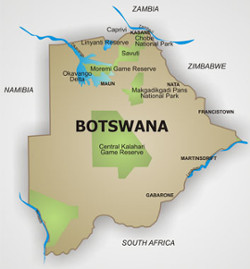
Around 10 percent of the population lives in the capital and largest city, Gaborone. Once one of the poorest countries in the world — with a GDP per capita of about US$70 per year in the late 1960s. Botswana has since transformed itself into one of the fastest-growing economies in the world, now boasting a GDP (purchasing power parity) per capita of about $16,400 per year as of 2013. Its high gross national income (by some estimates the fourth-largest in Africa) gives the country a modest standard of living and the second highest Human Development Index of continental Sub-Saharan Africa. [1]
Location Of Botswana

At 581,730․km2 (224,607․sq․mi) Botswana is the world's 48th-largest country. It is comparable in size to Madagascar or France. It lies between latitudes 17° and 27°S, and longitudes 20° and 30°E. The country is predominantly flat, tending toward gently rolling tableland. Botswana is dominated by the Kalahari Desert, which covers up to 70% of its land surface. The Okavango Delta, one of the world's largest inland deltas, is in the northwest. The Makgadikgadi Pan, a large salt pan, lies in the north.
The Limpopo River Basin, the major landform of all of southern Africa, lies partly in Botswana, with the basins of its tributaries, the Notwane, Bonwapitse, Mahalapswe, Lotsane, Motloutse and the Shashe, located in the eastern part of the country. The Notwane provides water to the capital through the Gaborone Dam. The Chobe River lies to the north, providing a boundary between Botswana and Namibia's Zambezi Region. The Chobe River meets with the Zambezi River at a place called Kazungula (meaning a small sausage tree, a point where Sebitwane and his Makololo tribe crossed the Zambezi into Zambia).[1]
The National Flag
The Botswana flag was officially adopted on September 30, 1966. The colours on the flag correspond to those on the national coat of arms. The blue represents water, the white-black-white bands depict the racial harmony of the people as well as the pluralist nature of the society.
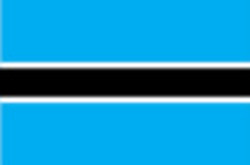
The Coat of Arms
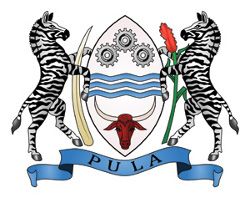
The coat of arms of Botswana was adopted on January 25, 1966. The centre shield is supported by two zebras. The shape of the shield is that of traditional shields found in East Africa. On the top portion of the shield are three cogwheels that represent industry.
The three waves symbolize water, and reminds the viewer of the motto of the nation: pula, which means simply "rain", but also good luck, and is the name of the nation's currency. This motto also highlights the importance of water to Botswana. The motto is found at the bottom of the coat of arms on a blue banner.
At the bottom of the shield is the head of a bull, which symbolizes the importance of cattle herding to Botswana. The two zebras are present since zebras are an important part of Botswana's wildlife. The zebra on the right holds an ear of sorghum, an important crop in the nation. The zebra on the left holds a tusk of ivory, symbolic of the former ivory trade in Botswana.
President Of Botswana
Mokgweetsi Eric Keabetswe Masisi (born 21 July 1961) is the 5th President of Botswana since 1 April 2018. He has also served as Minister of Education since 2014, and previously he was Minister of Presidential Affairs and Public Administration from 2011 to 2014. He was first elected to Parliament in 2009. Mokgweetsi Masisi is the son of Edison Masisi (1923-2003), the long-time MP for Moshupa and many-time cabinet member. The younger Masisi grew up in Gaborone, attending Thornhill Primary School and Maru-A-Pula School. In school, he competed in soccer and tennis, but ultimately found acting to be his calling. In 1984, he won acclaim for his portrayal of the lead role in a Gaborone production of Cry the Beloved Country, and was praised by the visiting Alan Paton for his performance. During the 1980s, he starred in numerous theatrical productions, and also had roles in South African B-Movies.
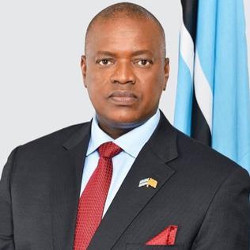
During the 1980s Masisi became a high school social studies teacher for several years after graduating from the University of Botswana in 1984 in English and History. He then taught at Mmanaana Secondary School in 1984 in Moshupa village before moving on to the University of Botswana in 1987 as a curriculum development specialist. In 1989 he went to Florida State University to obtain a Master's degree in Education, following which he was employed by UNICEF in Botswana. Masisi unsuccessfully sought the nomination of the ruling Botswana Democratic Party (BDP) to stand in Moshupa constituency in the 2004 general election. However, he obtained the BDP nomination for the same seat prior to the 2009 general election and won the seat. He was promptly appointed as Assistant Minister for Presidential Affairs and Public Administration in October 2009. After a little more than a year as an assistant minister, he was appointed as Minister for Presidential Affairs and Public Administration in January 2011. Masisi became Minister of Education and Skills Development in an acting capacity in April 2014; he was re-elected to his seat in Parliament in October 2014, and he was appointed as Minister of Education and Skills Development on 28 October 2014. Masisi was appointed by President Ian Khama as Vice President of Botswana on 12 November 2014 while remaining in his post as Minister of Education.[9]
Former Presidents
Lieutenant General Dr. Seretse Khama Ian Khama is the former President of The Republic of Botswana from 2008 to 2018; he is also the de facto Paramount Chief of the Bamangwato tribe. His Excellency Ian Khama was born on the 27th February 1953. After serving as Commander of the Botswana Defence Force, he entered politics and served as Vice-President of Botswana from 1998 to 2008, then succeeded Festus Mogae as President on 1 April 2008.
Ian Khama is the first-born son and second child of Sir Seretse Khama (1 July 1921–13 July 1980), who was the country's foremost independence leader and President from 1966 to 1980, and Lady Khama. He was born in Chertsey, Surrey during the period in which his father was exiled to the United Kingdom due to the opposition by the colonial government and the emergent apartheid regime in South Africa to his marriage to a white woman.
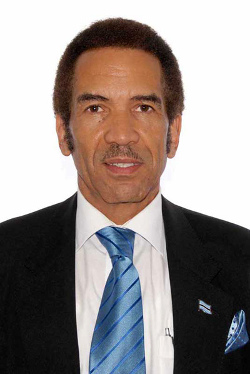
He is also the grandson of Sekgoma II (1869–1925), who was the paramount chief of the Bamangwato people, and the great-grandson of Khama III (1837–1923), their king; and the great-great grandson of Kgosikgolo Sekgoma I, the Chief of the Bamangwato people (1815–1885). The name "Seretse" means “the clay that binds together,” and was given to his father to celebrate the recent reconciliation of his father and grandfather; this reconciliation assured Seretse’s Khama's own ascension to the throne with his aged father’s death in 1925. Seretse Khama Ian Khama is named after his father to continue this historical legacy. He is also known simply as Ian Khama to differentiate between himself and his father. Tshekedi Khama II, Ian Khama's brother, was named after their great uncle, Tshekedi Khama who was the regent and guardian for Kgosi Seretse Khama, the first President of Botswana.
Ian Khama is an alumnus of Waterford Kamhlaba, a United World College in Mbabane, Swaziland. He is a qualified pilot and attended Royal Military Academy Sandhurst, where the British Army trains its officers. [4]
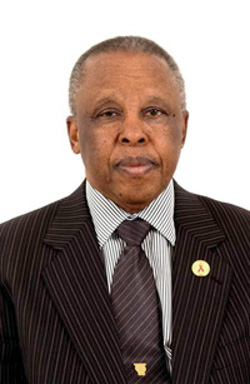
Festus Gontebanye Mogae is the former President of the Republic of Botswana from 1998 to 2008. He was born on the 21 August 1939 and succeeded Quett Masire as President in 1998 and was reelected again in October 2004; after ten years in office, he stepped down in 2008 and was succeeded by Lieutenant General Ian Khama. He is married to Barbara Mogae, and they have three children: Chedza, Nametso and Boikaego.
Mogae is of Kalanga descent, from Serowe. This Kalanga group is called Badhalaunda, named after their king, Dhalaunda, and his native language is Kalanga.
Mogae studied economics in the United Kingdom, first at University College, Oxford, and then at the University of Sussex. He returned to Botswana to work as a civil servant before taking up posts with the International Monetary Fund and the Bank of Botswana. He was Vice-President of Botswana from 1992 to 1998.
Mogae's party, the Botswana Democratic Party (BDP), retained power in the October 1999 general election, and Mogae was sworn in for a five-year term on 20 October 1999 by Chief Justice Julian Nganunu at the National Stadium in Gaborone. On this occasion, he vowed to focus on the fight against poverty and unemployment.
Following the BDP's victory in the October 2004 general election, Mogae was sworn in for another term on 2 November 2004. Mogae promised to tackle poverty and unemployment, as well as the spread of HIV-AIDS, which he pledged to stop in Botswana by 2016.
On 14 July 2007, Mogae affirmed his intention to resign nine months later.
Mogae was awarded the Grand Cross of the Légion d'honneur by French President Nicolas Sarkozy on 20 March 2008 for his "exemplary leadership" in making Botswana a "model" of democracy and good governance. He stepped down as President on 1 April 2008 and was succeeded by Vice-President Ian Khama. [5]
Quett Ketumile Masire, (born 23 July 1925 in Kanye, Botswana) was the second President of Botswana from 1980 to 1998. He stepped down and was succeeded by the then Vice-President of Botswana, Mr Festus Mogae, who became the third President of Botswana. Prior to this, he was a leading figure in the independence movement and then the new government, and played a crucial role in facilitating and protecting Botswana’s steady financial growth and development. From an early age Masire set himself apart through academic achievement. After graduating at the top of his class at the Kanye school, he received a scholarship to further his education at the Tiger Kloof Educational Institute in South Africa.
In 1958 Masire was appointed as the protectorate reporter for the African Echo/Naledi ya Botswana newspaper. He was also elected to the newly reformed Bangwaketse Tribal Council and, after 1960, the protectorate-wide African and Legislative Councils. Although he attended the first Kanye meeting of the People's Party, the earliest nationalist grouping to enjoy a mass following in the territory, he declined to join the movement. [6]

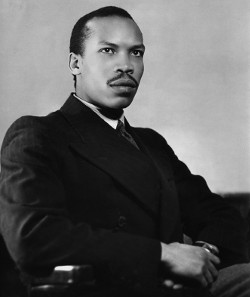
Sir Seretse Khama, ( July 1, 1921 – July 13, 1980) was a statesman from Botswana. Born into one of the more powerful of the royal families of what was then the British Protectorate of Bechuanaland, and educated abroad in neighbouring South Africa and in the United Kingdom, he returned home with a popular but controversial bride to lead his country's independence movement. He founded the Botswana Democratic Party in 1962 and became Prime Minister in 1965. In 1966, Botswana gained independence and Seretse became the first president. During his presidency, the country underwent rapid economic and social progress.
He was the son of Sekgoma Khama II, the paramount chief of the Bamangwato people, and the grandson of Khama III, their king. At the age of four, Seretse became kgosi (king), with his uncle Tshekedi Khama as his regent and guardian.
After spending most of his youth in South African boarding schools, Khama attended Fort Hare University College there, graduating with a general B.A. in 1944. He then travelled to the United Kingdom and spent a year at Balliol College, Oxford, before joining the Inner Temple in London in 1946, to study to become a barrister. [7]
Origins of Botswana
In the 19th century, hostilities broke out between Tswana inhabitants of Botswana and Ndebele tribes who were making incursions into the territory from the north-east. Tensions also escalated with the Dutch Boer settlers from the Transvaal to the east. After appeals by the Batswana leaders Khama III, Bathoen and Sebele for assistance, the British Government put Bechuanaland under its protection on 31 March 1885. The northern territory remained under direct administration as the Bechuanaland Protectorate and is modern-day Botswana, while the southern territory became part of the Cape Colony and is now part of the northwest province of South Africa. The majority of Setswana-speaking people today live in South Africa.


When the Union of South Africa was formed in 1910 out of the main British colonies in the region, the Bechuanaland Protectorate, Basutoland (now Lesotho) and Swaziland (the High Commission Territories) were not included, but provision was made for their later incorporation. However, their inhabitants began to be consulted by the UK, and although successive South African governments sought to have the territories transferred, the UK kept delaying; consequently, it never occurred. The election of the Nationalist government in 1948, which instituted apartheid, and South Africa's withdrawal from the Commonwealth in 1961, ended any prospect of incorporation of the territories into South Africa. An expansion of British central authority and the evolution of tribal government resulted in the 1920 establishment of two advisory councils to represent both Africans and Europeans. Proclamations in 1934 regulated tribal rule and powers. A European-African advisory council was formed in 1951, and the 1961 constitution established a consultative legislative council.
In June 1964, the UK accepted proposals for a democratic self-government in Botswana. The seat of government was moved in 1965 from Mafikeng in South Africa, to the newly established Gaborone, which sits near its border. The 1965 constitution led to the first general elections and to independence on 30 September 1966.
Seretse Khama, a leader in the independence movement and the legitimate claimant to the Ngwato chiefship, was elected as the first President, going on to be re-elected twice. The presidency passed to the sitting Vice-President, Quett Masire, who was elected in his own right in 1984 and re-elected in 1989 and 1994. Masire retired from office in 1998, and was succeeded by Festus Mogae, who was elected in his own right in 1999 and re-elected in 2004. The presidency passed in 2008 to Ian Khama (son of the first President), who had been serving as Mogae's Vice-President since resigning his position in 1998 as Commander of the Botswana Defence Force to take up this civilian role. [1]
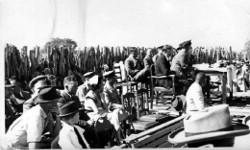
Governance
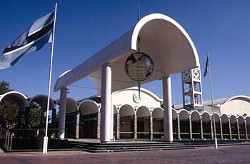
The Constitution of Botswana is the rule of law which protects the citizens of Botswana and represents their rights. The politics of Botswana take place in a framework of a representative
democratic republic, whereby the President of Botswana is both head of state and head of government, and of a multi-party system. Executive power is exercised by the government. Legislative
power is vested in both the government and the Parliament of Botswana. The most recent election, the eleventh, was held on 24 October 2014.
Since independence was declared, the party system has been dominated by the Botswana Democratic Party. The judiciary is independent of the executive and the legislature. According to Transparency
International, Botswana is the least corrupt country in Africa and ranks similarly close to Portugal and South Korea. [1]
The People
The Tswana are the majority ethnic group in Botswana, making up 79% of the population. The largest minority ethnic groups are the BaKalanga, San also known as Basarwa. Other tribes are Bayei,
Bambukushu, Basubia, Baherero and Bakgalagadi. In addition, there are small numbers of whites and Indians, both groups being roughly equally small in number. Botswana's Indian population is
made up of many Indian-Africans of several generations, from Mozambique, Kenya, Tanzania, Mauritius, South Africa, and so on, as well as first generation Indian immigrants. The white population
speaks English and Afrikaans and makes up roughly 3% of the population.
Since 2000, because of deteriorating economic conditions in Zimbabwe, the number of Zimbabweans in Botswana has risen into the tens of thousands.[1]
The estimated population of Botswana from the 2022 Population and Housing Census is 2,346,179 with an estimated 8,279 citizens outside the country during census period.

Languages

The official language of Botswana is English although Setswana is widely spoken across the country. In Setswana, prefixes are more important than they are in many other languages. These prefixes include Bo, which refers to the country, Ba, which refers to the people, Mo, which is one person, and Se which is the language. For example, the main tribe of Botswana is the Tswana people, hence the name Botswana for its country. The people as a whole are Batswana, one person is Motswana, and the language they speak is Setswana. Other languages spoken in Botswana include Kalanga (sekalanga), Sarwa (sesarwa), Sekgalagadi and Afrikaans in some parts. [1]
District Divisions
Botswana is divided into nine districts;
- Central District
- North-West District
- Ghanzi District
- Kgalagadi District
- Kgatleng District
- Kweneng District
- North-East District
- South-East District
- Southern District
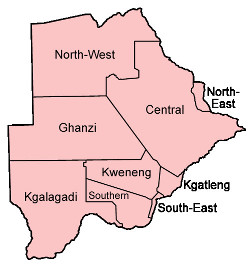
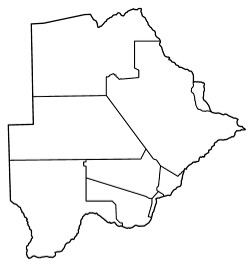

Weather
Botswana's climate is semi-arid. Though it is hot and dry for much of the year, there is a rainy season, which runs through the summer months. Rainfall tends to be erratic, unpredictable and highly regional. Often a heavy downpour may occur in one area while 10 or 15 kilometres away there is no rain at all. Showers are often followed by blistering heat/sunshine so that a good deal of the rainfall does not penetrate the ground but is lost to evaporation and transpiration.
'Pula', one of the most frequently heard words in Botswana, is not only the name of Botswana's currency, but also the Setswana word for rain. So much of what takes place in Botswana relies on this essential, frequently scarce commodity. [1]

Seasons
The summer season begins in November and ends in March. It usually brings very high temperatures. However, summer is also the rainy season, and cloud coverage and rain can cool things down considerably, although only usually for a short period of time.
The winter season begins in May and ends in August. This is also the dry season when virtually no rainfall occurs. Winter days are invariably sunny and cool to warm; however, evening and night temperatures can drop below freezing point in some areas, especially in the southwest.
The in-between periods - April/early May and September/October - still tend to be dry, but the days are cooler than in summer and the nights are warmer than in winter. [1]
[2] http://www.worldatlas.com/webimage/flags/countrys/africa/botswana.htm
[3] http://en.wikipedia.org/wiki/Coat_of_arms_of_Botswana
[4] http://en.wikipedia.org/wiki/Ian_Khama
[5] http://en.wikipedia.org/wiki/Festus_Mogae
[6] http://en.wikipedia.org/wiki/Quett_Masire
[7] http://en.wikipedia.org/wiki/Seretse_Khama
[8] http://www.botswanatourism.co.bw/climate
[9] https://en.wikipedia.org/wiki/Mokgweetsi_Masisi
















